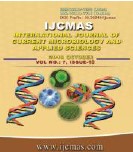


 National Academy of Agricultural Sciences (NAAS)
National Academy of Agricultural Sciences (NAAS)

|
PRINT ISSN : 2319-7692
Online ISSN : 2319-7706 Issues : 12 per year Publisher : Excellent Publishers Email : editorijcmas@gmail.com / submit@ijcmas.com Editor-in-chief: Dr.M.Prakash Index Copernicus ICV 2018: 95.39 NAAS RATING 2020: 5.38 |
Coastal Odisha is one of the most flood prone areas of India where the paddy crop in the wet season is often devastated by flash floods with an average productivity of only 0.5–0.8 t ha⻹. The present study showed that farmers preferred to cultivate low yielding traditional land races owing to their better flood tolerance and the unavailability of flood tolerant high yielding varieties (HYVs). The main goal of this study is to identify new genetic resources tolerant to submergence based on morpho-physiological traits. Field experiment comprising 22 varieties which were completely submerged for 15 days under RBD design was conducted to screen out the submergence tolerant varieties basing upon morpho-physiological characters in the costal ecosystem of Odisha during kharif 2015 in the Adaptive Research Station, Sakhigopal. Greater genetic variability was observed for different physiological parameters. There was highly positive correlation between LAI, NAR, RGR CGR and LAD with yield and yield attributing characters which are found to be highest in varieties like Sabita, FR-43B and Jalamagna. NAR is positively associated with SLW and negatively with LAR. So all these can be selected as useful parameters for selection of a variety to have higher grain yield.
 |
 |
 |
 |
 |